2013 Peugeot 508 ECO mode
[x] Cancel search: ECO modePage 194 of 340
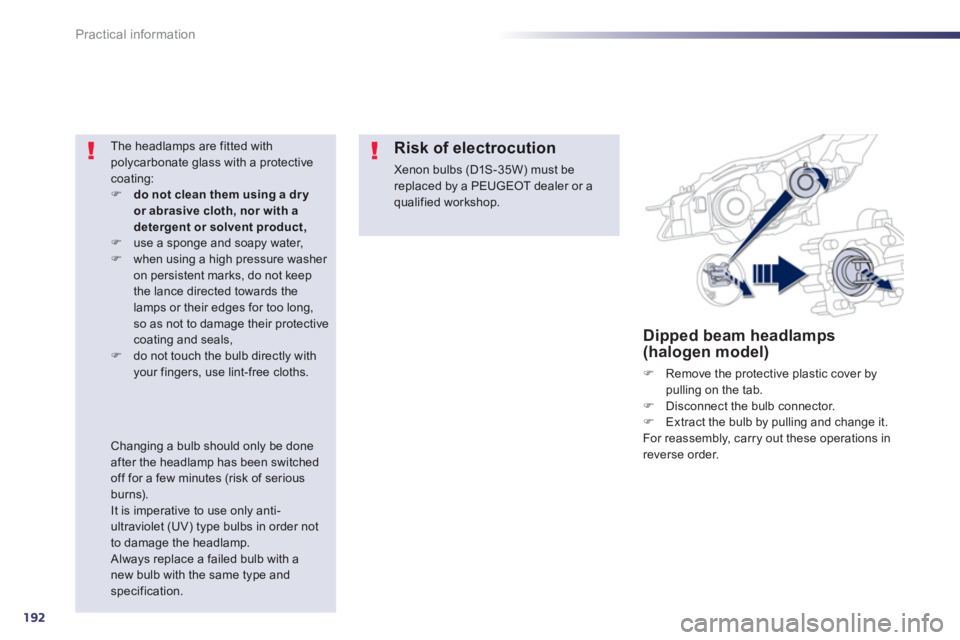
192
Practical information
Dipped beam headlamps(halogen model)
F Remove the protective plastic cover by pulling on the tab.F
Disconnect the bulb connector.F
Extract the bulb by pulling and change it.
For reassembly, carry out these operations in
reverse order.
The headlamps are fitted with
polycarbonate glass with a protectivecoating:Fdo not clean them using a dryor abrasive cloth, nor with adetergent or solvent product,F
use a sponge and soapy water, F
when using a high pressure washer on persistent marks, do not keepthe lance directed towards thelamps or their edges for too long,so as not to damage their protectivecoating and seals,F
do not touch the bulb directly withyour fingers, use lint-free cloths.
Risk of electrocution
Xenon bulbs (D1S-35W) must bereplaced by a PEUGEOT dealer or aqualified workshop.
Changing a bulb should only be doneafter the headlamp has been switched off for a few minutes (risk of seriousburns). It is imperative to use only anti-ultraviolet (UV) type bulbs in order notto damage the headlamp. Always replace a failed bulb with a new bulb with the same type andspecification.
Page 195 of 340
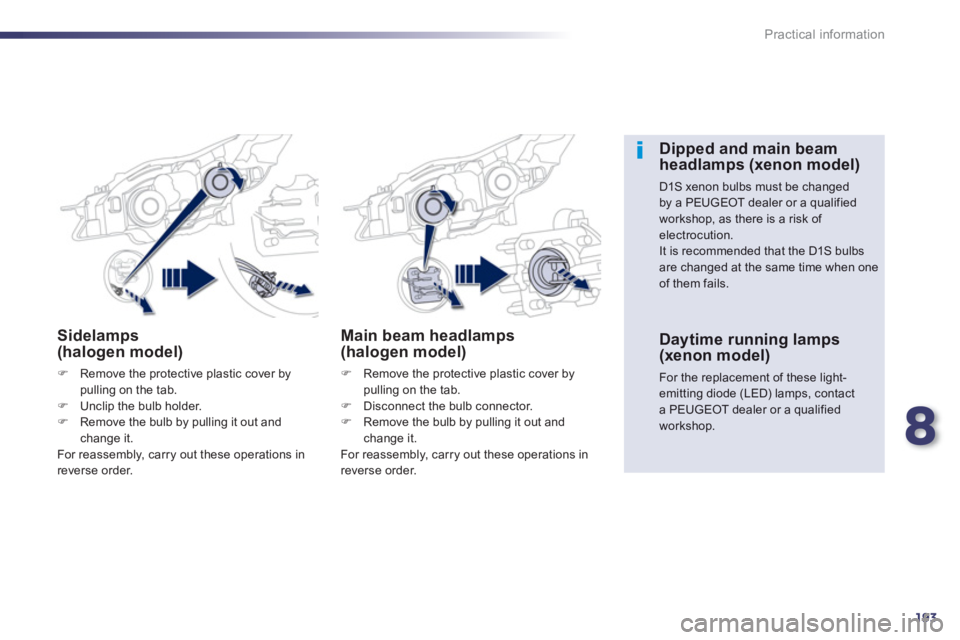
8
193
Practical information
Sidelamps(halogen model)
FRemove the protective plastic cover bypulling on the tab.FUnclip the bulb holder. FRemove the bulb by pulling it out and change it.
For reassembly, carry out these operations in
reverse order.
Main beam headlamps(halogen model)
FRemove the protective plastic cover by
pulling on the tab. FDisconnect the bulb connector.
FRemove the bulb by pulling it out and
change it.
For reassembly, carry out these operations in reverse order.
Dipped and main beam
headlamps (xenon model)
D1S xenon bulbs must be changedby a PEUGEOT dealer or a qualifiedworkshop, as there is a risk of electrocution.
It is recommended that the D1S bulbsare changed at the same time when oneof them fails.
Daytime running lamps
(xenon model)
For the replacement of these light-emitting diode (LED) lamps, contacta PEUGEOT dealer or a qualifiedworkshop.
Page 208 of 340

206
Practical information
The batteries contain harmful substancessuch as sulphuric acid and lead. They must be disposed of in accordance with regulations and must not, in anycircumstances, be discarded with household waste.
Take used remote control batteries andvehicle batteries to a special collection point.
Do not reverse the polarity and use only a 12 V charger.
Do not disconnect the terminals whilethe engine is running.
Do not charge the batteries without disconnecting the terminals first. Do not push the vehicle to star t the engine if it is fitted with the 6 -speed electronic gearbox system or an automatic gearbox.
It is advisable to disconnect the 12 Vbattery if the vehicle is to be left unusedfor more than one month.
Before disconnecting the battery
Wait 2 minutes after switching off the ignitionbefore disconnecting the 12 V battery.
Close the windows and the doors beforedisconnecting the battery.
Following reconnection of thebattery
Following reconnection of the 12 V battery,
switch on the ignition and wait 1 minute before
star ting to permit initialisation of the electronic
systems. However, if problems remain followingthis operation, contact a PEUGEOT dealer or a
qualified workshop.
Referring to the corresponding section, you
must yourself reinitialise:
- the remote control key,
- the panoramic sunroof blind,
- the GPS satellite navigation system.
Load reduction mode
System which manages the use of cer tain
functions according to the level of charge
remaining in the battery.
When the vehicle is bein
g driven, the load
reduction function temporarily deactivates certain functions, such as the air conditioning,
the heated rear screen...
The deactivated functions are reactivated
automatically as soon as conditions permit.
Page 209 of 340
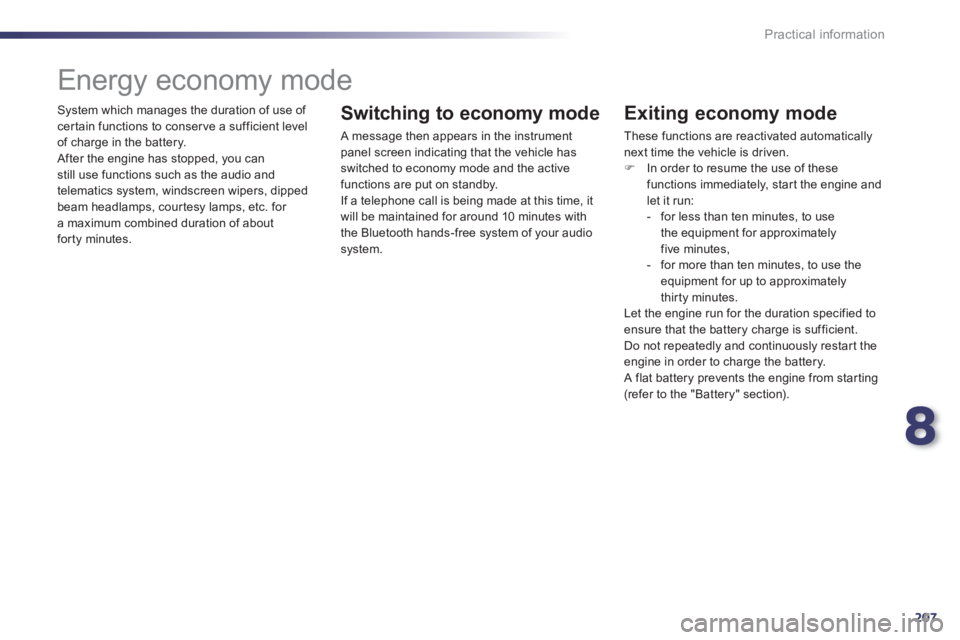
8
207
Practical information
System which manages the duration of use of certain functions to conserve a sufficient level
of charge in the battery.
After the engine has stopped, you can still use functions such as the audio andtelematics system, windscreen wipers, dipped
beam headlamps, cour tesy lamps, etc. for a maximum combined duration of aboutforty minutes.
Energy economy mode
Switching to economy mode
A message then appears in the instrument panel screen indicating that the vehicle has
switched to economy mode and the active
functions are put on standby.
If a telephone call is being made at this time, it
will be maintained for around 10 minutes with
the Bluetooth hands-free system of your audio
system.
Exiting economy mode
These functions are reactivated automatically
next time the vehicle is driven.
F In order to resume the use of thesefunctions immediately, star t the engine and let it run:
- for less than ten minutes, to use
the equipment for approximatelyfive minutes,
- for more than ten minutes, to use the
equipment for up to approximatelythirty minutes.
Let the engine run for the duration specified toensure that the battery charge is sufficient.
Do not repeatedly and continuously restar t theengine in order to charge the battery.
A flat battery prevents the engine from star ting (refer to the "Battery" section).
Page 230 of 340
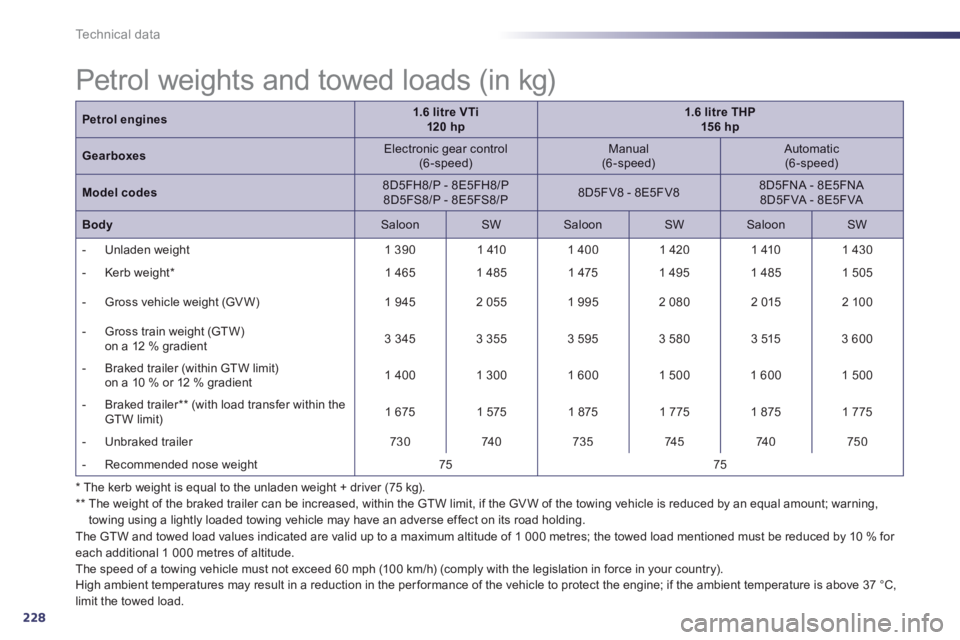
228
Technical data
*
The kerb weight is equal to the unladen weight + driver (75 kg). **
The weight of the braked trailer can be increased, within the GTW limit, if the GVW of the towing vehicle is reduced by an equal amount; warning,
towing using a lightly loaded towing vehicle may have an adverse effect on its road holding.
Petrol weights and towed loads (in kg)
The GTW and towed load values indicated are valid up to a maximum altitude of 1 000 metres; the towed load mentioned must be reduced by 10 % for each additional 1 000 metres of altitude.
The speed of a towing vehicle must not exceed 60 mph (10 0 km/h) (comply with the legislation in force in your country).
High ambient temperatures may result in a reduction in the performance of the vehicle to protect the engine; if the ambient temperature is above 37 °C,
limit the towed load.
Petrol engines1.6 litre V Ti120 hp1.6 litre THP156 hp
GearboxesElectronic gear control(6-speed)
Manual(6-speed)
Automatic(6-speed)
Model codes
8D5FH8/P - 8E5FH8/P 8D5FS8/P - 8E5FS8/P 8D5FV8 - 8E5FV8
8D5FNA - 8E5FNA 8D5FVA - 8E5FVA
BodySaloon
SW
Saloon SW
Saloon
SW
- Unladen wei
ght 1 390
1 410
1 400
1 420
1 410
1 430
- Kerb weight *
1 465 1 485
1 475 1 495
1 485
1 505
- Gross vehicle wei
ght (GV W)
1 945 2 0551 9952 080
2 015 2 10 0
- Gross train weight (GTW)
on a 12 % gradient 3 3453 355
3 595
3 5803 515
3 600
- Braked trailer
(within GTW limit) on a 10 % or 12 % gradient1 400
1 3001 6001 500
1 600
1 500
- Braked trailer ** (with load transfer within the
GTW limit) 1 675 1 575 1 875 1 7751 875 1 775
-
Unbraked trailer
730
740735
745
740
750
- Recommended nose weight 7575
Page 231 of 340
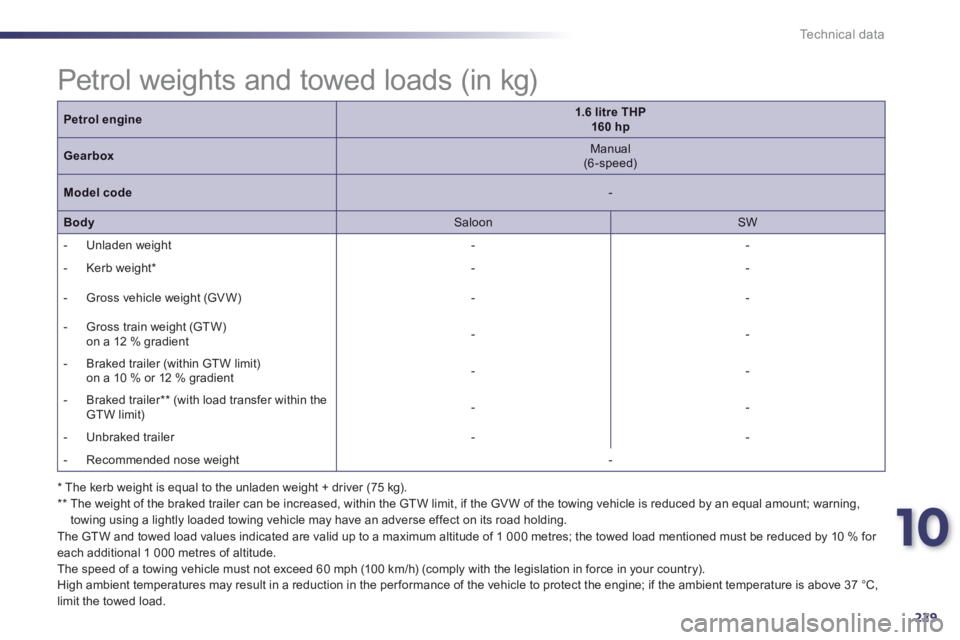
10
229
Technical data
Petrol engine1.6 litre THP 160 hp
Gearbox
Manual(6-speed)
Model code
-
Body
Saloon
SW
- Unladen wei
ght -
-
- Kerb weight
*-
-
- Gross vehicle wei
ght (GV W)
-
-
-
Gross train weight (GTW)
on a 12 % gradient --
- Braked trailer (within GTW limit) on a 10 % or 12 % gradient--
- Braked trailer ** (with load transfer within the
GTW limit) -
-
-
Unbraked trailer --
- Recommended nose weight
-
*
The kerb weight is equal to the unladen weight + driver (75 kg). **
The weight of the braked trailer can be increased, within the GTW limit, if the GVW of the towing vehicle is reduced by an equal amount; warning,
towing using a lightly loaded towing vehicle may have an adverse effect on its road holding.
Petrol weights and towed loads (in kg)
The GTW and towed load values indicated are valid up to a maximum altitude of 1 000 metres; the towed load mentioned must be reduced by 10 % for each additional 1 000 metres of altitude.
The speed of a towing vehicle must not exceed 60 mph (10 0 km/h) (comply with the legislation in force in your country).
High ambient temperatures may result in a reduction in the performance of the vehicle to protect the engine; if the ambient temperature is above 37 °C,
limit the towed load.
Page 235 of 340
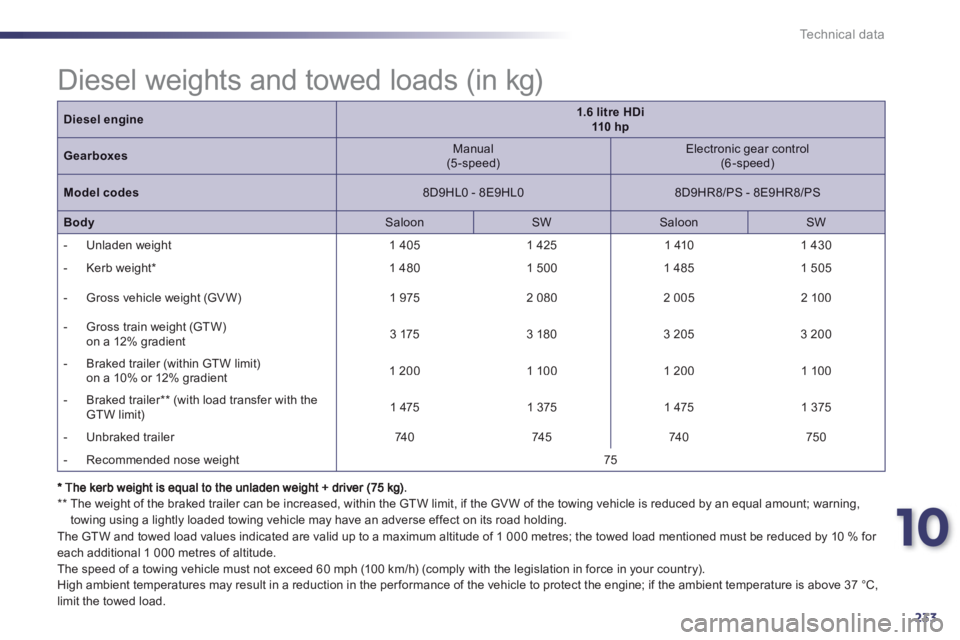
10
233
Technical data
**
The weight of the braked trailer can be increased, within the GTW limit, if the GVW of the towing vehicle is reduced by an equal amount; warning,
towing using a lightly loaded towing vehicle may have an adverse effect on its road holding.
The
GTW and towed load values indicated are valid up to a maximum altitude of 1 000 metres; the towed load mentioned must be reduced by 10 % for each additional 1 000 metres of altitude.
The speed of a towing vehicle must not exceed 60 mph (10 0 km/h) (comply with the legislation in force in your country).
High ambient temperatures may result in a reduction in the performance of the vehicle to protect the engine; if the ambient temperature is above 37 °C,
limit the towed load.
Diesel weights and towed loads (in kg)
Diesel engine1.6 litre HDi 110 hp
Gearboxes
Manual(5-speed)
Electronic gear control (6-speed)
Model codes8D9HL0 - 8E9HL0
8D9HR8/PS - 8E9HR8/PS
BodySaloonSW
SaloonSW
- Unladen wei
ght 1 4051 425 1 410
1 430
- Kerb weight
*
1 480 1 500
1 485 1 505
- Gross vehicle wei
ght (GV W)
1 975 2 080
2 005 2 10 0
-
Gross train weight (GTW)
on a 12% gradient 3 175
3 180
3 205
3 200
- Braked trailer
(within GTW limit) on a 10% or 12% gradient
1 200
1 100
1 200
1 100
- Braked trailer **
(with load transfer with the
GTW limit) 1 475
1 375
1 475
1 375
-
Unbraked trailer
740
745740
750
- Recommended nose wei
ght
75
Page 236 of 340

234
Technical data
2.0 litre HDi140 hp2.0 litre HDi163 hp
GearboxesManual (6-speed)
Automatic
(6-speed)
Manual (6-speed)
Model codes
8DRHR8 - 8ERHR8
8DRHF8 - 8ERHF8
8DRHHA - 8ERHHA 8DRHDA - 8ERHDA
8DRHH8 - 8ERHH8
OutlineSaloon
SW
Saloon SW
Saloon
SW
- Unladen wei
ght1 430
1 500
1 520
1 540
1 480
1 500
- Kerb weight *
1 505
1 575
1 595
1 615 1 555 1 575
- Gross vehicle wei
ght (GV W)
2 065 2 1402 105 2 18 0
2 075 2 140
-
Gross train weight (GTW)
on a 12% gradient3 665 3 640
3 405
3 380
3 675
3 640
- Braked trailer (within GTW limit) on a 10% or 12% gradient
1 600
1 5001 300
1 200
1 600
1 500
- Braked trailer ** (with load transfer with the
GTW limit) 1 8751 775
1 575
1 4751 875
1 775
-
Unbraked trailer
750
750
- Recommended nose wei
ght 7575
*
The kerb weight is equal to the unladen weight + driver (75 kg). **
The weight of the braked trailer can be increased, within the GTW limit, if the GVW of the towing vehicle is reduced by an equal amount; warning,
towing using a lightly loaded towing vehicle may have an adverse effect on its road holding.
The
GTW and towed load values indicated are valid up to a maximum altitude of 1 000 metres; the towed load mentioned must be reduced by 10 % for each additional 1 000 metres of altitude.
The speed of a towing vehicle must not exceed 60 mph (10 0 km/h) (comply with the legislation in force in your country).
High ambient temperatures may result in a reduction in the performance of the vehicle to protect the engine; if the ambient temperature is above 37 °C,
limit the towed load.
Diesel weights and towed loads (in kg)